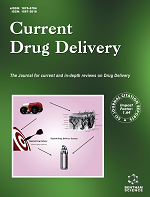- Home
- A-Z Publications
- Current Drug Delivery
- Previous Issues
- Volume 20, Issue 2, 2023
Current Drug Delivery - Volume 20, Issue 2, 2023
Volume 20, Issue 2, 2023
-
-
DNA Nanobots – Emerging Customized Nanomedicine in Oncology
More LessAuthors: Rajesh Singh and Rohitas DeshmukhCancer is one of the most lethal diseases of the twenty-first century. Many medicines, including antitumor antibiotics, deliver tedious and severe chemotherapy and radiation treatment, both of which have significant side effects. DNA nanorobots, as an alternative, might be used as a cancer treatment method that is both safer and more precise than current treatments. DNA nanobots are being praised as a major milestone i Read More
-
-
-
Nanostructured Lipid Carriers for the Delivery of Natural Bioactive Compounds
More LessAuthors: Nur Amira Mohd. Shamsuddin and Mohd. H. ZulfakarNatural products contain bioactive compounds that are produced naturally via synthetic or semisynthetic processes. These bioactive compounds play significant biological roles, especially for growth as well as in defense mechanisms against pathogens. Bioactive compounds in natural products have been extensively studied in recent decades for their pharmacological activities, such as anticancer, wound healing, anti- Read More
-
-
-
Exploring Nose to Brain Nano Delivery for Effective Management of Migraine
More LessAuthors: Vidhi Tanna, Sujata P. Sawarkar and Padmini RavikumarMigraine is a disabling disease characterized by severe throbbing headaches. Patients demand quick relief from this pain. The presence of the blood-brain barrier does not permit the drug to penetrate the brain effectively. Administration of conventional anti-migraine medications via oral route leads to erratic absorption of drugs. Delayed gastric emptying is also responsible for the ineffective absorption of the drug. Migrai Read More
-
-
-
Enhanced Bioavailability and Higher Uptake of Brain-Targeted Surface Engineered Delivery System of Naringenin developed as a Therapeutic for Autism Spectrum Disorder
More LessAuthors: Ranjana Bhandari, Jyoti K Paliwal and Anurag KuhadBackground: Neuroinflammation resulting from oxidative and nitrosative stress is associated with various neurological disorders and involves the generation of pro-inflammatory cytokines and microglial activation. Dietary phytochemicals are safer and more valuable adjunct neurotherapeutic agents which can be added to the therapeutic regimen. These compounds provide neuroprotection by the modulation of various signali Read More
-
-
-
Preparation and Quality Evaluation of Honokiol Nanoparticles Using a New Polysaccharide Polymer as its Carrier
More LessAuthors: Ye Weng, Hongyan Zhang, Shujun Xu, Yue Zhao, Lisha Ma, Jingbin Shi, Ke Qian, Weizong Liang and Yang XiongObjective: To improve the solubility of Honokiol (HNK), Honokiol nanoparticles (HNK-NPs) were prepared using a new biodegradable polysaccharide polymer as its carrier. Methods: HNK-NPs were prepared by hydrophilic polymer coagulation method, and the processing parameters were optimized according to average particle size and PDI by a single factor experiment. The morphology of the optimized nanoparticles was Read More
-
-
-
Hyperthermia-sensitive Liposomes Containing Brucea Javanica Oil for Synergistic Photothermal-/Chemo-Therapy in Breast Cancer Treatment
More LessAuthors: Yan Huang, Qianying Zhang, Peipei Feng, Weihuan Li, Xiuru Li, Yongjie Li and Di ZhangIntroduction: High mortality and limited therapeutic efficacy of clinical treatment make breast cancer a stubborn disease in women. The hypovascular issue is the main challenge needed to be overcome in breast cancer treatment. Methods: For this purpose, hyperthermia-sensitive liposomes containing indocyanine green (ICG) and brucea javanica oil (BJO) (LP(BJO/ICG)) were constructed for near-infrared (NIR) laser- Read More
-
-
-
Rectal Administration of Celecoxib Liquid Suppositories with Enhanced Bioavailability and Safety in Rats
More LessAuthors: Yan Jiao, Shijing Xie, Abdul Baseer and Fakhar Ud-dinBackground: Celecoxib is generally used for the treatment of rheumatoid arthritis, however its poor bioavailability and cytotoxicity in pure form have reduced its therapeutic efficacy. This study aims to develop celecoxib liquid suppositories with improved bioavailability and reduced toxicity. Methods: The celecoxib liquid suppositories were prepared by thoroughly mixing celecoxib, poloxamer 188 and poloxamer 407, and twe Read More
-
Volumes & issues
-
Volume 22 (2025)
-
Volume 21 (2024)
-
Volume 20 (2023)
-
Volume 19 (2022)
-
Volume 18 (2021)
-
Volume 17 (2020)
-
Volume 16 (2019)
-
Volume 15 (2018)
-
Volume 14 (2017)
-
Volume 13 (2016)
-
Volume 12 (2015)
-
Volume 11 (2014)
-
Volume 10 (2013)
-
Volume 9 (2012)
-
Volume 8 (2011)
-
Volume 7 (2010)
-
Volume 6 (2009)
-
Volume 5 (2008)
-
Volume 4 (2007)
-
Volume 3 (2006)
-
Volume 2 (2005)
-
Volume 1 (2004)
Most Read This Month
Article
content/journals/cdd
Journal
10
5
false
en

Most Cited Most Cited RSS feed
-
-
Preface
Authors: Deng-Guang Yu and He Lv
-
- More Less

